Following the success of the first edition, JUNTOS APARTE set out on a journey far beyond its initial programme. Mobilising an even greater public and engaging mass civilian participation in a reflection on art at the border, it increased its national and international visibility, participating in various sites of debate, such as the UNESCO Communications Chair at the Universidad Javeriana de Bogotá, the 16th Global South Forum of the BIENALSUR in Buenos Aires, and the 2nd Americas Cultural Summit in Buenos Aires, where it was the official voice for “Cultural Changes and Migration”.
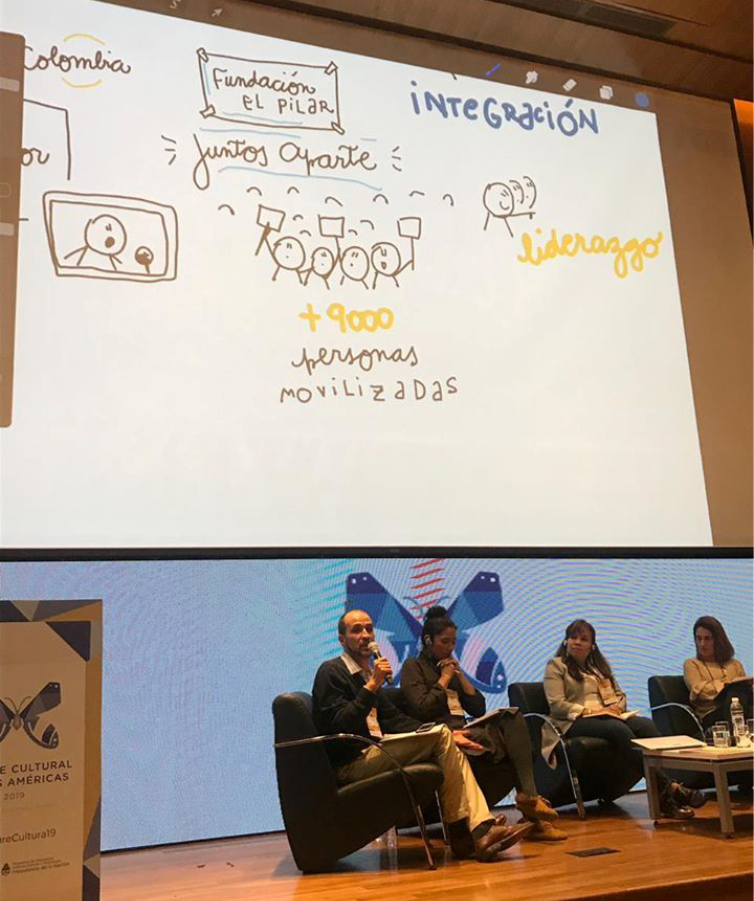
This track record has led to the consolidation of those institutional and private partners who believed in the initiative since the start, as well as the support of the Presidency of the Republic from its Venezuela Border Management, the Ministry of Culture and the Ministry of Foreign Affairs, and the direct support of USAID International Development Agency and ACDI/VOCA through their Alliances for Reconciliation Program, IOM (International Organisation for Migration) with the support of the Bureau of Population, Refugees, and Migration of the US Department of State, and diplomatic representations such as the Canadian and Spanish embassies in Colombia.
The second edition of JUNTOS APARTE 2019 involved the participation of 97 artists* and thinkers, of which 57 hailed from 24 countries, whilst 12 were national and 28 regional (Norte de Santander and Táchira). In this version, a progressive route addressed the concept of borders and human mobility, taking the essential notions of state and territory as starting points to then cover the economic, geopolitical, social, and cultural variables that intervene on these phenomena, constructing a narrative from the general to the particular.
The República Andina exhibition marked the pre–inaugural event, consisting in the second presentation of the Gran Colombia trilogy, begun by Antonio Caro in 2017 and resulting from a workshop with local emerging artists. Meanwhile, the Caravana de la Hermandad convened more than a thousand people who walked for kinship and regional alliance. Together, members of civil society, international cooperation organisations, local entrepreneurs, members of state bodies, and the art community crossed the city centre accompanying the binational artistic intervention MiSsÉxodo / Estandarte para golondrinas —a boat of over thirteen-metres in length that used to cross the río Táchira between Colombia and Venezuela on a daily basis— reaching the Centro Cultural Quinta Teresa, where the poetic disembarkation took place.
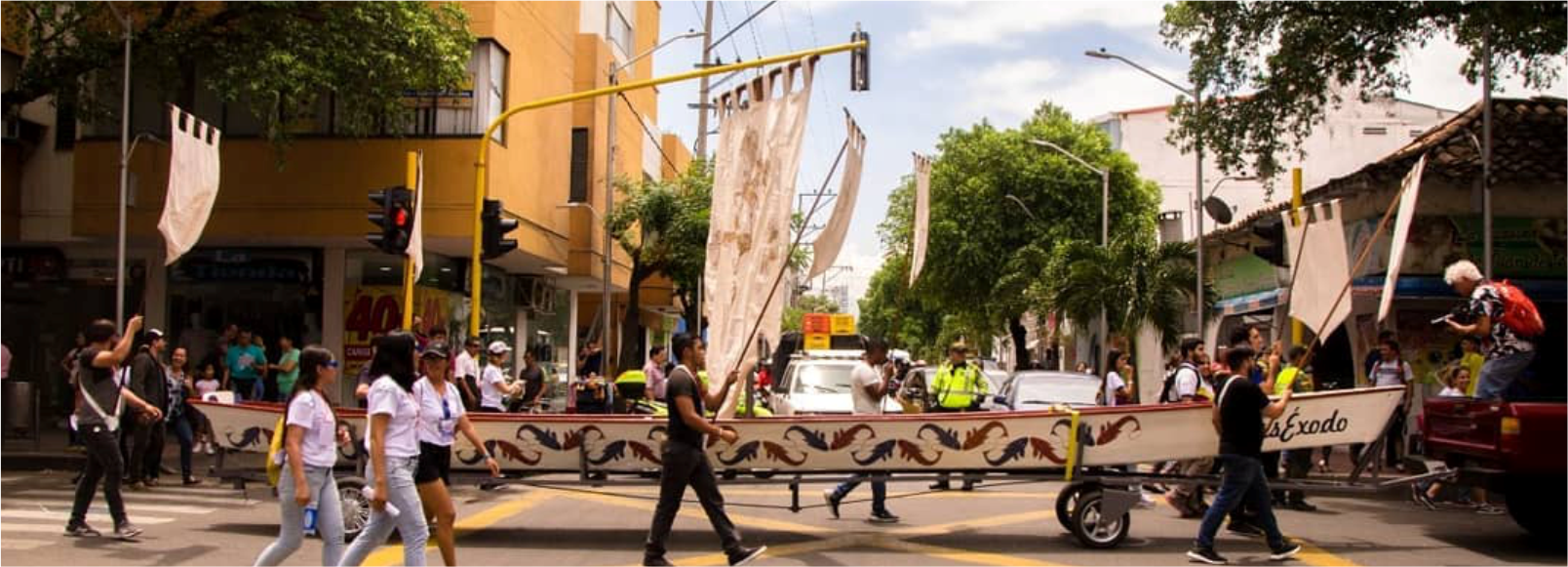
The exhibition circuit began with the show es_ta_do_na_ción in the Museo Norte de Santander y ciudad de Cúcuta, setting the general context as that of the nation-state, the system of political organisation in force since the seventeenth century through which the existing border model was established, as well as its current crisis of representation. In the Biblioteca Pública Julio Pérez Ferrero, the exhibition Entre toche y guayaba madura —local adaptation of the popular Colombian saying “pelea de tigre con burro amarrado” (a fight between a tiger and a tied-up donkey)— uses this analogy of inequality to approach the relationship between centre and periphery, a concept that starts with the economy to then extend to the political, social, and cultural. The Casa Museo Torre del Reloj, housed the third exhibition, Sigan bailando (Despierte al vecino), reminding us that the history of migration is that of humanity, an enduring struggle replete with misunderstandings among cultures, ethnicities, beliefs, classes and genders. The circuit ended in the Centro Cultural Quinta Teresa with the show El puente está quebrado, an exercise in the recovery of the traces of border dialogue via turn-of-the-century artistic production from both sides of the Río Táchira. To date, this is the greatest collection of works concerning the regional border, allowing the public to appreciate the transformation of the border model from the artistic perspective. Of particular note was the homage to mentor Luis Miguel “Lucho” Brahim (CO), standard bearer of regional culture and co-founder of Juntos Aparte, who passed away in 2019. Equally important was the participation of Beatriz González (CO).

*Participating artists in the 2019 exhibition circuit: Adrián Preciado (VE), Alán Carrasco (PE/ES), Alexandra Gelis and Jorge Lozano (VE/CO), Alexandra Morelli (CO), Angie Jácome (CO), Amparo Cárdenas (CO), Andrés Duplat (CO), Andrés Moreno Hoffmann (CO), Avelino Sala (ES), Azahara Cerezo (ES), Betsabeé Romero (MX), Calentado Producciones (CO), Carlos Martiel (CU), Carmen Ludene (VE), Ciprian Homorodean (RO), Dan Perjovschi (RO), Daniel Arévalo (CO), Daniela Ortiz (PE), David Grimaldo (CO), Diana Villamizar (VE), Esperanza Mayobre (VE), Francesc Ruiz Abad (ES), Gabriel Castillo (CO), Gabriela Sierra (CO), Giuliana Racco (CA), Glenda León (CU/ES), Iván Candeo (VE), Jorge García (ES), Jaime Martínez “Pekoz” (CO), José Luis Gélvez (CO), Juan Carvajal Franklin (CO), Juan Pablo Cohen (CO), Juan Pablo Echeverri (CO), Julio Armando Ortiz (CO), Khaled Jarrar (PS), Lester Rodríguez (HN), Luis Molina-Pantín (VE/CH), Marcos Ávila Forero (FR/CO), María Belén Hernández (CO), Mauricio Sánchez (CO), MO Colectivo (CO), Mohamed Arejdal (MA), Nicolás Cadavid (CO), Nohemí Vega (CO), Núria Güell (ES), Ñukanchik People (EC), Oier Gil (ES), Oscar Iván Roque (CO), Paola Cañizares (CO), PSJM (ES), Ramón Mateos (ES), Richard Moncada (VE), Samir Quintero (CO), Santiago Vélez (CO), Sebastián Delgado (CO), Sergio Durán “Bayo” (CO/VE), Timea Oravecz (HU), Verena Melgarejo Weinandt (DE/BO), Wilmer Useche (CO), Xenia Hausner (AT), Yael Bartana (IL), and Yu-Wen Wu (TW).
For the 2019 site-specific project, Argentinian artist, photographer, and activist Marcelo Brodsky developed a brief and prolific residency from which three lines of work emerged. Firstly, he altered two emblematic images of Juan Pablo Cohen, photographer and visual reporter of the border for the local newspaper La Opinión. Brodsky drew over photographs of the Simón Bolívar and Tienditas bridges —the first inundated with a tide of people and the second blocked by containers. He also intervened on cartographic pieces from the Archivo General de la Nación —the failed plan to overthrow the Barí indigenous population, a vision of contemporary nomadism in what was foreseen as the Gran Colombia, a note on the arrival of the conquistadors as the first great migration of America— and he composed significant polyptychs moving from scenes of the Puente Internacional Simón Bolívar and the Caravana de la Hermandad Juntos Aparte 2019 that he himself photographed, proposing a reading of the symbolic exchange between the groups and their contexts.
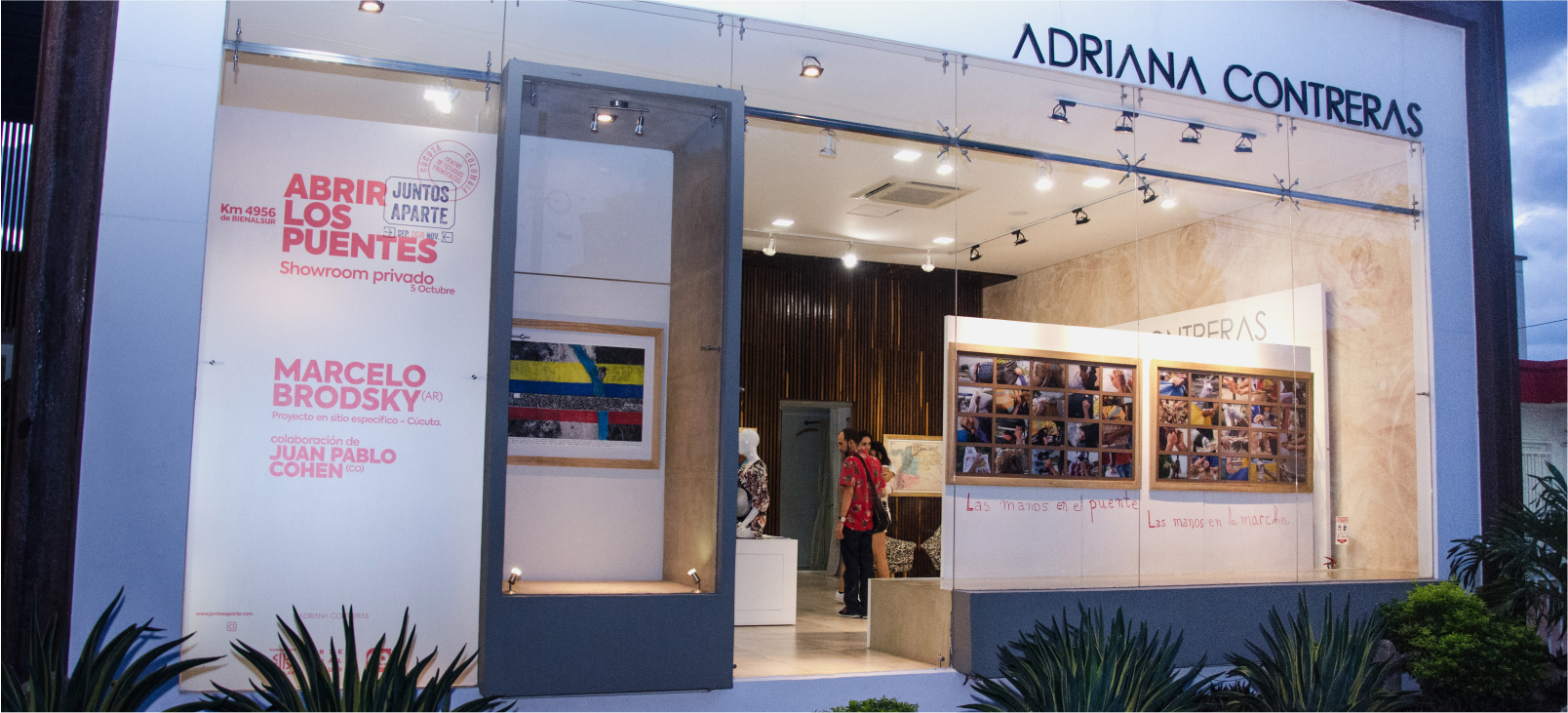
The second contextual workshop, Mental Border Control, led and developed by Melle Smets (NL) and Natalia Castillo (CO), incorporated local universities Uniminuto, UFPS and Unipamplona in research on how mental limits affect the construction of the physical landscape and social surroundings. “More mental limits mean less open space. Less open space means less options for the development of civil coexistence.” The exhibition of the results in the Museo de la Memoria de Cúcuta functioned as a space for exchange with Cúcuta residents and established an intelligent dialogue with the installation by special guest, renowned conceptual artist and educator, Luis Camnitzer (UY).
The strengthening of the pedagogical programme allowed for students, artists, leaders, thinkers, and citizens in general to approach the concepts of border and human movement from perspectives such as feminism, ethnic diversity, the environment, the culture of peace, economic impact, and cultural activism. This included a round table with prominent local actors —scholar Esperanza Paredes (CO), professor Mario Zambrano (CO), civic leader Eduardo Espinel (VE), and researcher Kenny Sanguino (CO)— and a series of conferences and workshops by relevant figures, such as academic and activist, Yuderkys Espinosa (DO), the artistic-academic director of the BIENALSUR, Diana Wechsler (AR), the director of UNESCO’s Global Centre for Peace, Guy Djoken, artists such as Giuliana Racco (CA), Ramón Mateos (ES), and Verena Melgarejo (DE/BO), the photographer Gabriela Sierra (CO), and the Bogotá-based school, El Validadero Artístico (CO).

Meanwhile, the repertoire of the Ciclo Audiovisual, approached themes of the border and migration from the audiovisual perspective, expanding beyond video art —Ana Montenegro (CO), Jess X Snow and Patrick Weishampel (CH/US), Vasco Araujo (PT)—, to include cinematography —Cary Fukunaga (US), Martti Helde (EE), Pablo Giorgelli (AR)—and documentary —El COLEF (MX) and Ai Wei Wei (CN). In addition, moving from the sessions in the city centre, the cycle expanded to reach the Centre for Temporary Attention for Migrants along the border and the La Fortaleza neighbourhood, bringing a special film programme to the community through a day of coexistence and integration.
Los caminantes de la frontera, the visionary sculptural intervention developed in 2013 by José Luis Zuñiga (ES) and María Villacorta (ES) during their residency at Fundación El Pilar, once again crisscrossed the metropolitan area of Cúcuta accompanied by specific activities in five emblematic points, where passers-by and residents interacted with the effigies. Initially conceived to speculate on border identity and produced in collaboration with various artists and communities, these walkers, transformed by a turn of events into a real social landscape through the bodies of those departing from Venezuela and moving across South America, returned to public space to activate it as a stage for mediation and civic construction.
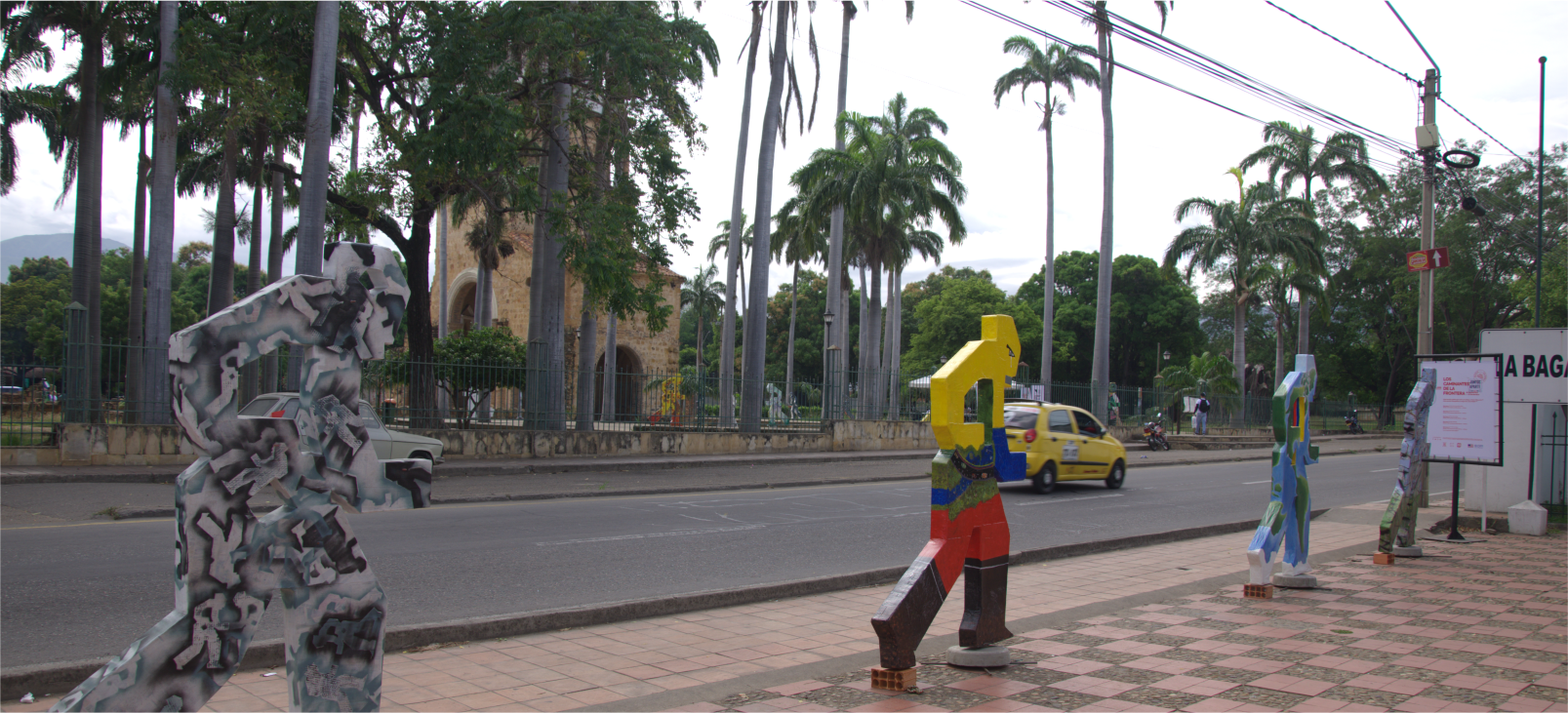
Also occupying public space, Carretilleras sobre el Puente Internacional Simón Bolívar, a photo-mural by Teresa Margolles (MX) —invited to develop a site specific work for Juntos Aparte 2017— focused on the women who transport other people’s goods as a means of border subsistence. Set in the centre of Cúcuta, the work dialogued with the urban art festival ATACARTE, which summons young local and international artists year after year.
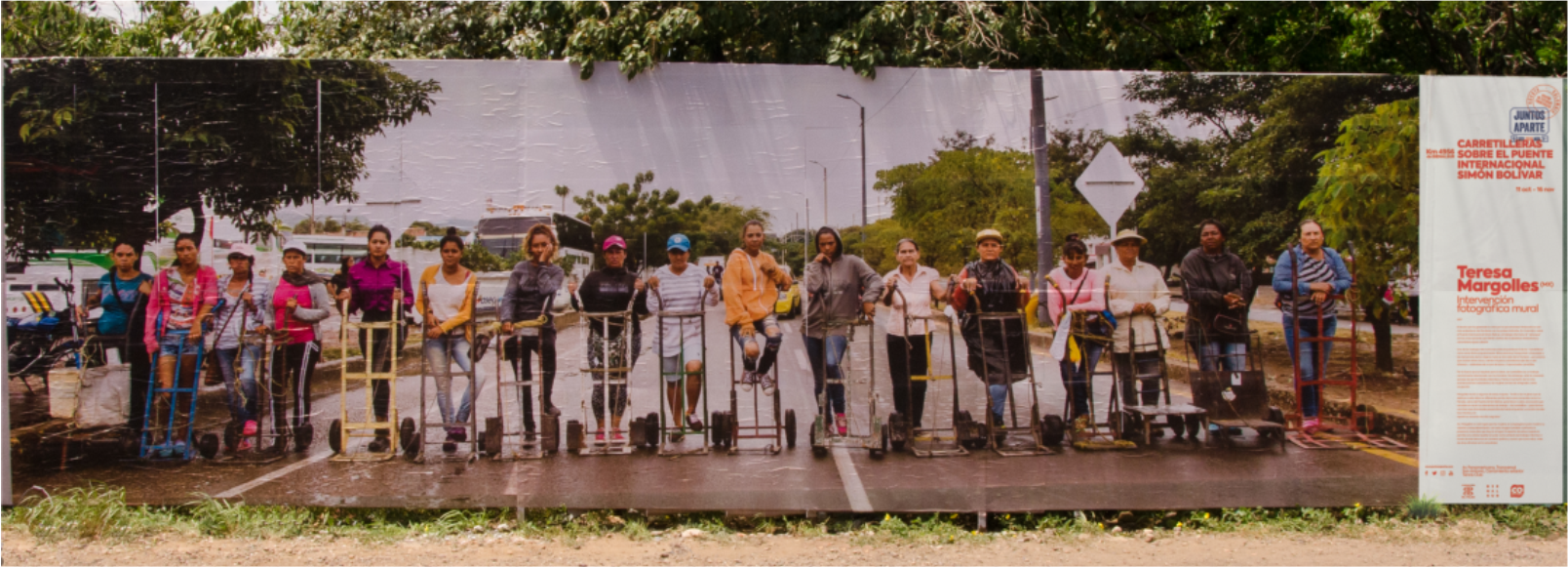
Rastros comunes was presented at the Universidad Minuto de Dios, a binational gathering recuperating the accounts of the Salón Binacional de Arte —a regional model closed down after almost two decades of activity— organised by masters Jorge Hernández (CO), Rafael Sánchez (VE) and Otto Rosales (VE) and the long-aspired Cátedra Colombia-Venezuela —regional inter-university programme on border studies— led by researcher Jonathan Carrero (VE), including the presentation of a new collaborative work by the legendary local art collective Taller el Hueco (CO), and culminating in the launch of the books El Ferrocarril de Cúcuta and La casa en la frontera.
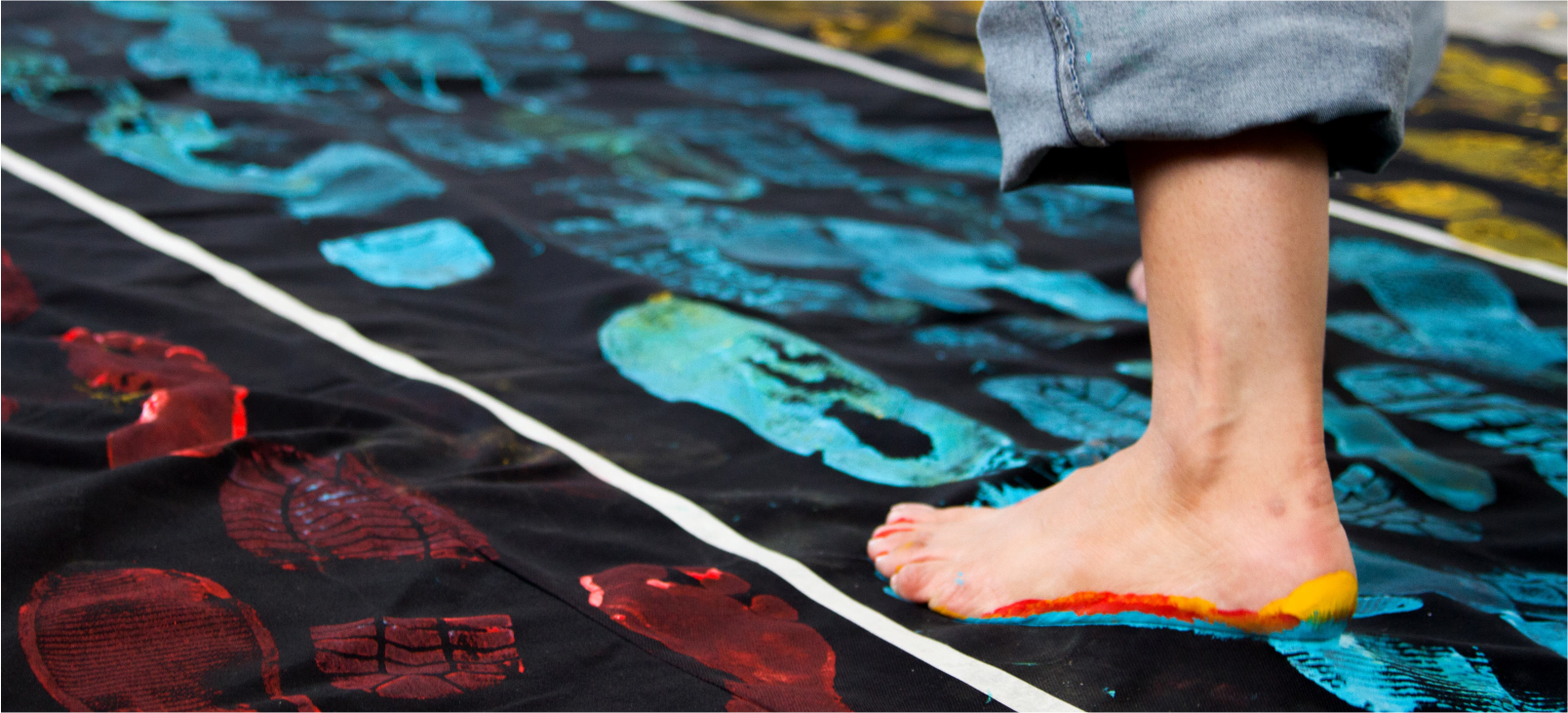
The intervention Voces para transformar a Colombia was developed in collaboration with the Centro Nacional de Memoria Histórica; an installation in the Biblioteca Pública Julio Pérez Ferrero conceived as a space for dialogue and cultural exchange starting from gastronomic memory. The presentation included a round table with victims of the armed conflict, an artwork by local urban artist Yeider Sánchez “Showy” (CO), and a live concert by renowned rapper Ahiman (CO) accompanied with a binational culinary session.
Mediation was central to the 2019 edition with the initiation of the Escuela de Aprestamiento en Mediación Artística, in which a team composed of emerging artists, university students, and single mothers accompanied and directed visitors through the spaces of the activities. And finally, the commitment to different communities gave fruit to the Safari Infantil and Travesías JUNTOS APARTE; guided mediation tours for youth and adults from vulnerable communities —returnees, refugees, migrants, LGBTI, HIV, differently abled—, respectively. Furthermore, our team was strengthened with the incorporation of Venezuelan professionals, adopting the nature of this territory: a singular and united region.

2019 entailed the amplification of the range of JUNTOS APARTE, reaching the peripheries of the city, giving access to the most vulnerable and consolidating student participation, adding new institutional and business allies and incorporating international cooperation within the network that makes this endeavour possible. Likewise, the international artistic community as well as regional, national and international media were reached, positioning Cúcuta as a cultural epicentre and civil border.
The JUNTOS APARTE programme, along with the city of Cúcuta, are now a vertex of convergences: the multilateral convergence that gathers together civil society, public administration, diplomacy, international cooperation, business and academia, hinging on an emblematic and transformative project. The convergence of artists, thinkers, and local and global media on the concept of borders and human mobility. The convergence of all social classes, generations, ethnicities, and ways of life transforming us into points of coexistence, respecting diversity, dialogue and integration, in a precise apparatus with the mission and vision of the local government plan, which grants a central role to civic culture as an axis for development.
Unknown affinities, systems of beliefs, artistic devices and political languages have allowed for the coupling of ideologies and aspirations, of life histories and critical positions, granting the citizens of the frontier a mirror with which to reflect themselves for the first time in dialogue with different global perspectives, transcending the official discourse and participating in a collective process of construction of memory in real time.
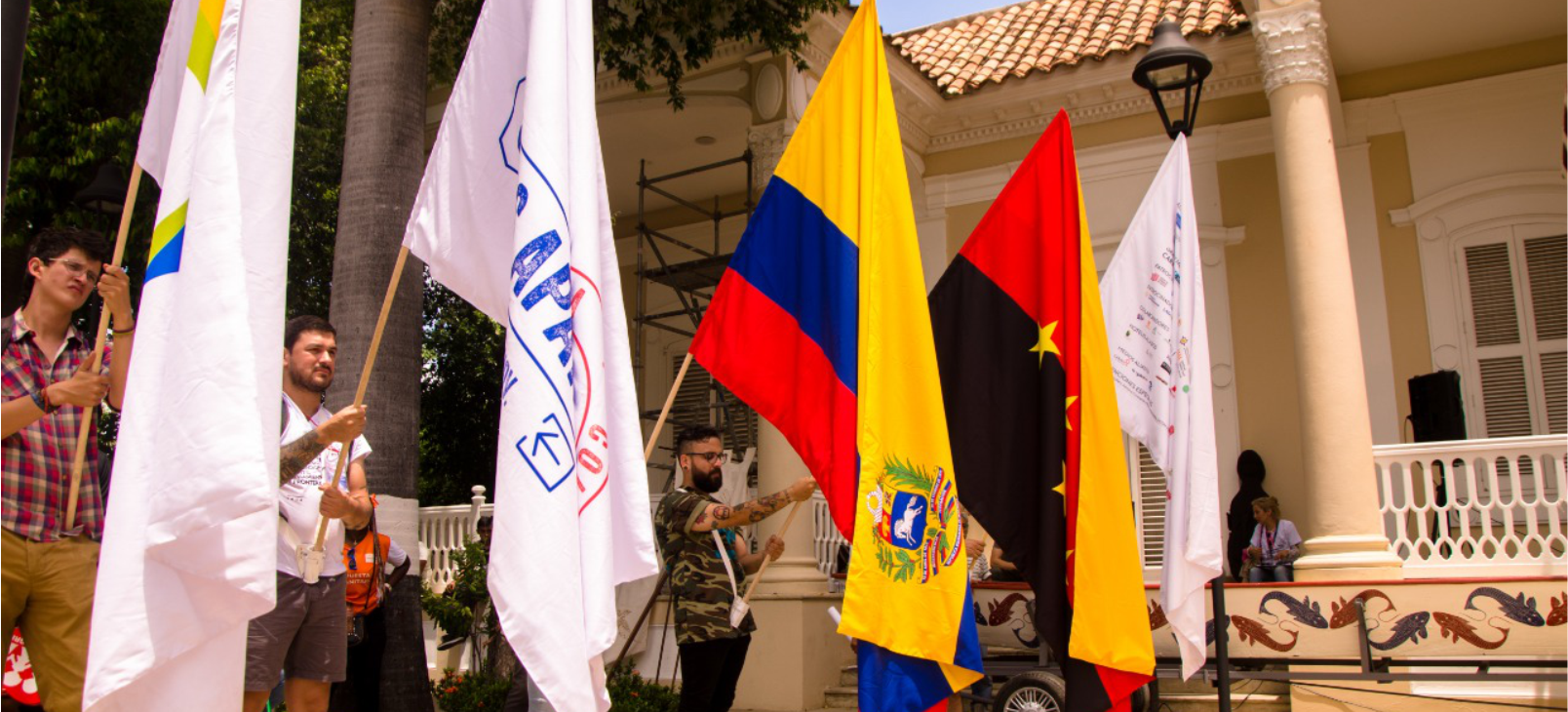
Empathy and coexistence emerge as the social engines of an extraordinary enclave, where democracy’s strength has been put to the test and where the main certainties are its potentiality and the will of an engaged network, including the management teams of JUNTOS APARTE and BIENALSUR, the programme participants, civil society, media, local entrepreneurs and a good part of the institutional players intervening in the region. The result has been highly positive, proven by the unprecedented amount of participation and citizen satisfaction, changes in perception concerning the region on the part of locals and foreigners, and the qualified training of a team of young professionals. More than spokespeople, we are catalysers of proposals that originate from and are aimed at society, inserting the border in the logics of global, artistic, cultural, economic, and cognitive exchange.
JUNTOS APARTE is preparing its third edition for 2021, within the official context of the Bicentenary of the Independence of Colombia. Under the title Reunión Artística Grancolombiana (Grancolombian Artistic Reunion) we will celebrate the ephemeris of a cancelled future: the second centenary of republican life in our country, with the signature of the Congress of the Constitution of Cúcuta, the effort of which consolidated the Independence of Spanish America and founded La Gran Colombia, Bolívar and Santander’s failed dream of a singular Latin America united under one nation. There where, today, the ideological rupture of the Americas is being played out like the newest version of the Cold War.
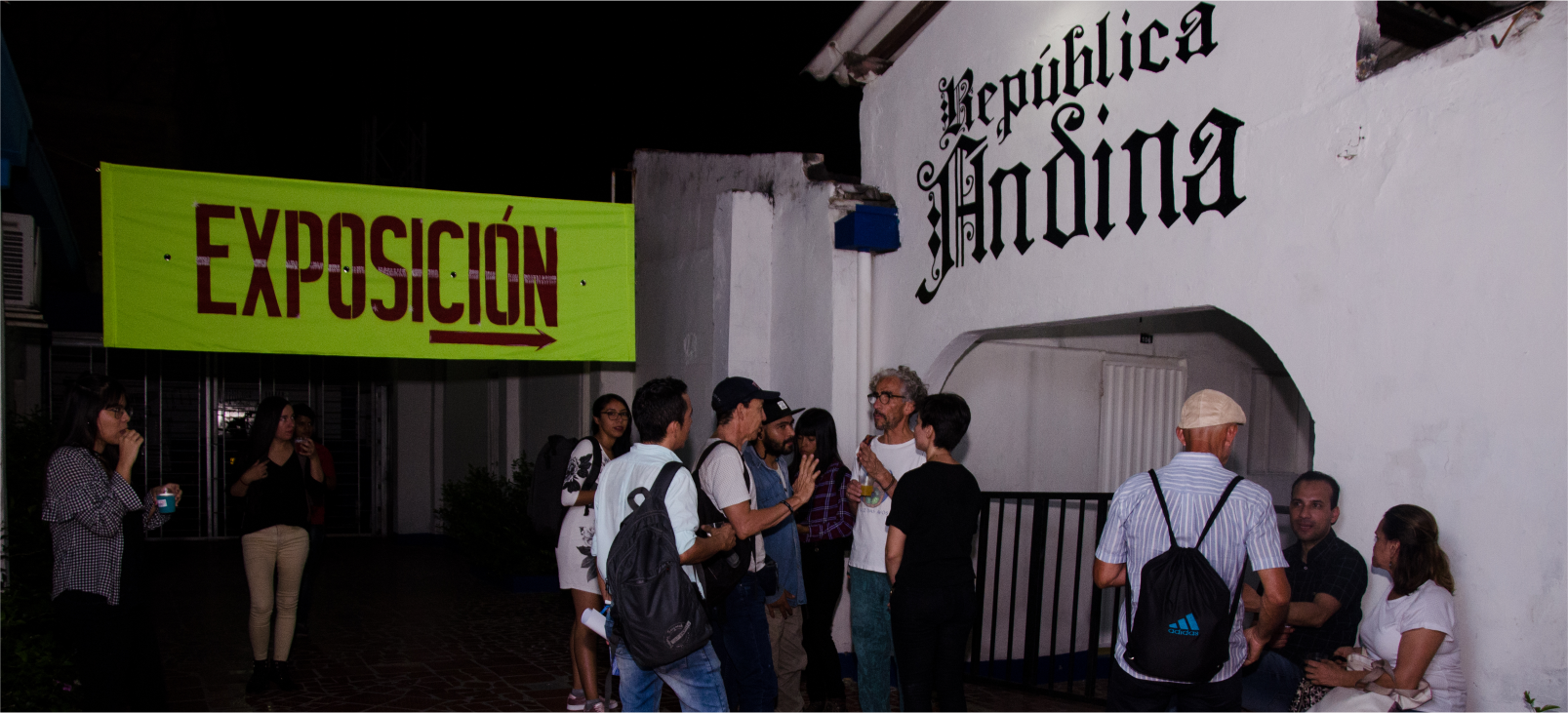
The entire unfolding of activities with the consequent generation of documentation and publications, constitute a preliminary action aimed at another medium and long-term initiative: The Centre for Border Studies (CEF), through which Cúcuta proposes itself as a catalyser of a process of dialogue and a permanent observatory of border phenomena, giving value to the nature and identity of the city and placing it clearly on the global map of culture and knowledge transfer.
Postulating that Colombians and Venezuelas, along with the inhabitants of all border areas, have always been and are still today TOGETHER APART, we are actively taking on our shared destiny, raising our voices from civil society to visibilize this silenced vertex of the public sphere. We propose initiatives focused on research and productivity on the Colombia-Venezuela border through the biennial JUNTOS APARTE Encuentro Internacional de Arte, Pensamiento y Fronteras in Cúcuta as a flagship project.
Among the projects of the Centre for Border Studies (CEF), there will be the activation of a Colombia-Venezuela Chair in collaboration with the Universidad de Los Andes in San Cristóbal, the Cúcuta Corporation Enlaces Centro de Investigación en Fronteras and the Universidad Minuto de Dios. In the mid-term, we foresee the development of a cooperative model for the CEF with three historical representatives: the Colegio de la Frontera Norte – COLEF of Tijuana, Mexico, the Universidad Nacional Tres de Febrero- UNTREF of Buenos Aires, the managing body of the BIENALSUR, and the Centro de Estudios Sociales of the Universidad de Coimbra in Portugal, under the direction of Boaventura de Sousa Santos. This is aimed to generate a project which connects cultural studies and border observatories with technologically driven programmes covering a range of knowledge and action from the production of specific theoretical knowledge down to the creation of concrete tools for territorial impact.
Precisely because art is a state of exception, we respond from the territory of art to the global emergency on our territory. Born of the roots of our historical identity, we propose Cúcuta as an epicentre of debate and the structuring of international thought concerning borders, betting on culture as a tool of convergence, on symbolic capital as a generator of value, and on civic construction as a productive engine.
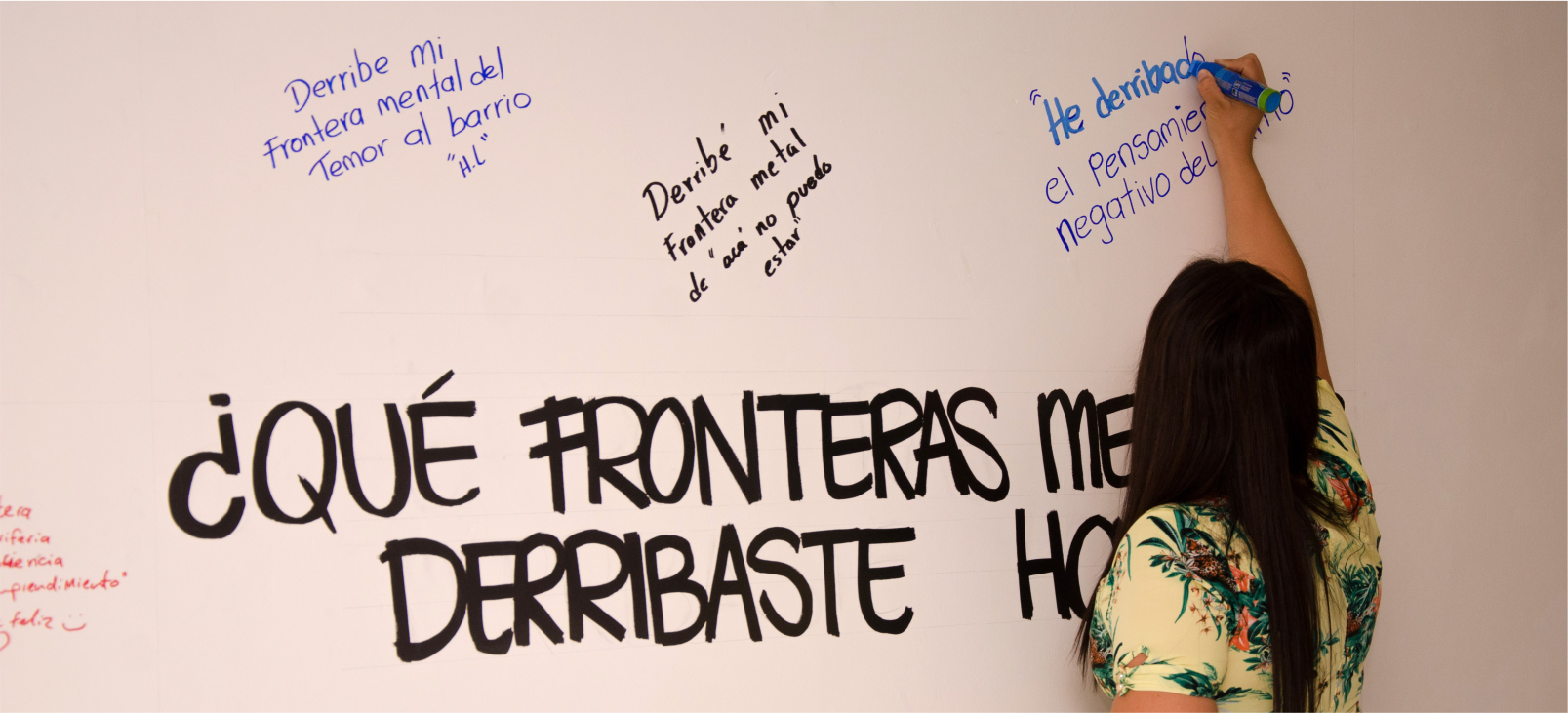
Humanizing the hostile forms of socialization handed down by decades of violence, fighting against xenophobia and aporophobia, questioning habits, constructing a social fabric based on inclusive logic, and resignifying the relationship locals and foreigners have with the region. These are the imminent challenges for the civic construction of the border area. The consequent understanding of a discursive structure on the border is the base of a civil consciousness upon which to build a public sphere in the growing conjuncture. Enhancing such work is decisive to guaranteeing integral programmatic development politics, fruit of civic participation and multilaterality. Art and culture constitute the vehicle for advancing in this direction. JUNTOS APARTE bets on being a container for the convergence of subjectivIties, committed to civic action at a local scale. In turn, artistic interventions from the global context receive enough attention to present new possibilities of tackling the real, of (re)knowing the territory and of forging identity. In this framework, assimilating art and culture as essential variables in the integral matrix of development, combining the production and transference of knowledge with the generation of tools for citizen intervention in the public sphere, has been our leitmotiv. It has also been the base of the shared principles for two initiatives synchronised in time, JUNTOS APARTE and BIENALSUR, dealing with “Art on the Borders,” “Transits and Migration” and “Art and Urgency”: a long-distance trans-border train whose route, as well as the new pan-American demography resulting from the Venezuelan exodus, is just beginning.
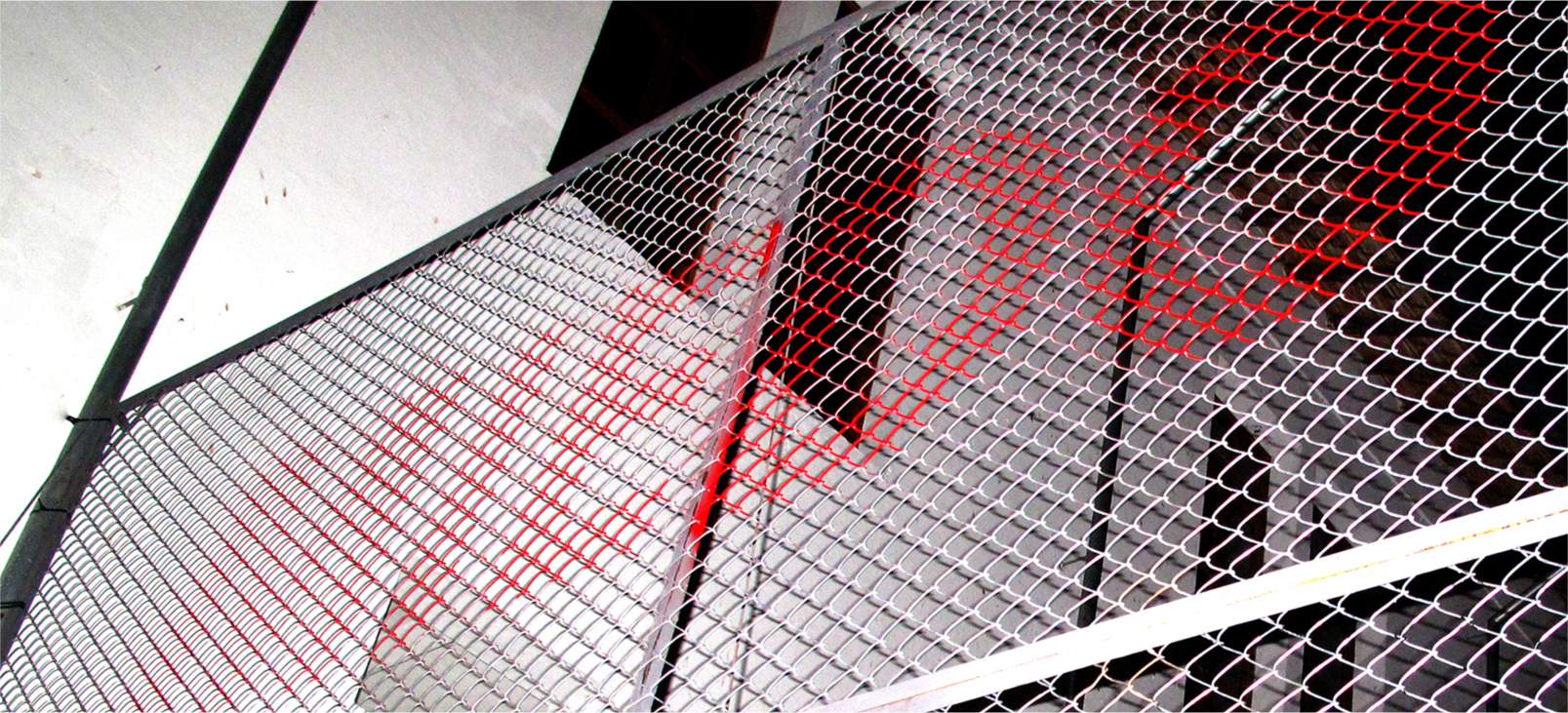
COVID-19 has put the contemporary global order, the spirit of the hive, modern capitalism, and our interaction with nature to the test. We are now tasked with the creation of new reflections for an ontology of enclosed space, starting from a global agenda that was declared during quarantine and managed to make everyone in the world, today more than ever, conscious of what it means to be TOGETHER APART.
